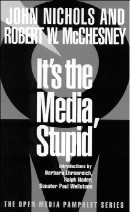In the book It’s the Media Stupid, Robert McChesney and John Nichols argue for a broad-based media reform movement that can make media democracy a central political issue in the United States. Here is their platform.
Expand funding for traditional public-service broadcasting with an eye toward making it fully non-commercial and democratically accountable. In particular, substantial new funding should be provided for the development of news and public affairs programming that would fill the gap created by the collapse of serious news gathering by the networks and their local affiliates.
Develop non-commercial, community-run, public-access television and radio systems that are distinct from public-service broadcasting and that are deeply rooted in local communities. As part of this initiative, the federal government should remove barriers to the development of microradio initiatives. Seed money, similar to that provided by the government and foundations for economic development in low-income and minority communities, should be targeted toward groups seeking to develop microradio.
Set far stricter standards for commercial broadcasters in exchange for granting them broadcast licenses. For example, why not ban or strictly limit advertising on children’s programs and news broadcasts? Why not take a percentage of the broadcaster’s revenues and set it aside for creative people and journalists to control time set aside for children’s shows and newscasts? Why not make it a condition of receiving a broadcast license that the broadcaster will not carry any paid political advertising during electoral campaigns? And that they will provide free time to all (liberally defined) viable candidates?
Create a broad initiative to limit advertising in general, using regulation and taxation to prevent commercial saturation.
Reassert anti-trust protections in order to limit the amount of media that can be owned by one firm. Why not, for example, limit radio stations to one per owner? The benefits of concentrated ownership accrue entirely to owners, not to the public. Make it government policy to encourage diversity of ownership and diversity of editorial opinions, as was intended by the First Amendment. There should, as well, be a reassertion of traditional restrictions on cross-ownership of media within particular communities.
Renew the commitment of the United States government to develop incentives aimed at encouraging and protecting minority ownership of broadcast and cable outlets.
Promote newspaper and magazine competition through the use of tax deductions or subsidies. One approach might allow taxpayers to deduct the cost of a limited number of newspaper and magazine subscriptions–as some professionals and academics now do. Such an initiative would boost the circulation of publications from across the ideological spectrum, but would be particularly helpful to publications that target low income, working-class, and elderly citizens, as well as students. Significantly lowered postal fees for nonprofit publications that have minimal advertising might also be appropriate.
Strengthen the position of media unions by encouraging the development of a stronger role for workers in determining editorial content of news publications and broadcast news. As in European countries, union protections in the U.S. should be strengthened in order to assure that working journalists are free to perform their duties with an eye toward serving the public interest.
Develop a new national program of subsidies for film and cultural production, particularly by members of ethnic and racial minority groups, women, low-income citizens, and others who frequently have a hard time finding market support for their artistic expressions.
Use tax breaks and subsidies to promote creation of publishing and production cooperatives and other arts and culture vehicles designed to provide non-commercial outlets for writers and artists to bring meaningful, controversial, and substantive work to mass audiences. One proposal put forth by economist Dean Baker would let any American redirect $150 from their tax payments to any nonprofit medium of their choice. (See story on page 2.) This could funnel as much as $25 billion into nonprofit media and create a very healthy competition among new and revitalized outlets for democratic and cultural expression. All this could be done without any government official gumming up the works.
In combination, these proposals would go a long way toward creating a strong democratic sector on the rapidly commercializing Internet, as every medium today has a web component almost by definition. Such media reform would not guarantee the end of injustice, poverty, or human misery, but it would provide a far superior basis for our society to address and confront the important issues of our time.
There would be no government censorship of media content. Any private individual could launch a commercial newspaper, or magazine, or website, and operate with all the freedom they currently enjoy–and with all the protection intended by the framers of the First Amendment. But Wall Street and Madison Avenue would no longer dominate our culture and journalism. There would be a variety of well-funded alternatives, both local and national, across all media. In this new world the marketplace of ideas would be a vibrant flowering garden, not the strip mall of chain stores we currently experience.
Reprinted with permission of the authors from It’s the Media Stupid by Robert McChesney and John Nichols, Seven Stories Press 2000.

